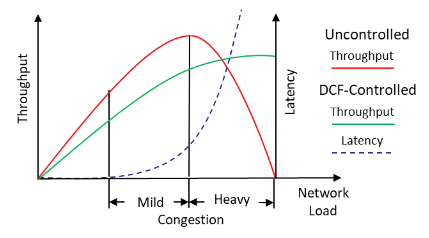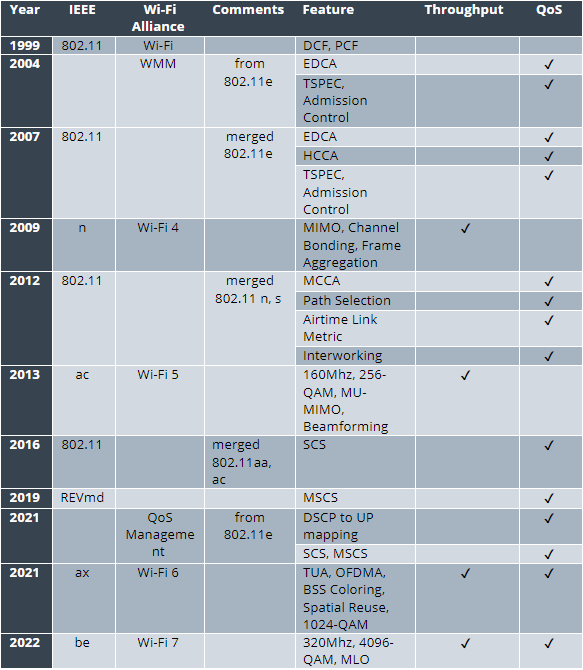Wi-Fi® has become indispensable to our daily lives, enabling seamless connectivity and access to a wide array of applications. As the demand for real-time services that require high data throughputs and minimal latency like augmented, virtual, and extended reality (AR/VR/XR) and high-definition video streaming continues to grow, it is crucial that there are mechanisms in place to enable a high-quality user experience. Quality of Service (QoS) plays an invaluable role in prioritizing and managing network traffic to deliver optimal performance, and Wi-Fi is poised to meet users’ increasing demands for unerring connectivity.
The early days of Wi-Fi and the need for QoS
Early iterations of Wi-Fi operated on a “best effort” basis, treating all traffic equally without differentiating based on priorities. While this approach ensured fairness in accessing wireless connectivity, it proved inadequate for applications requiring real-time data transmission with time-bounded latency, such as audio and video streaming. As these applications became increasingly common, the need for QoS mechanisms in Wi-Fi became apparent.

The figure shows network throughput versus network load, with two curves representing different congestion regions. The left side indicates no congestion, while the right side shows congested conditions, resulting in decreased throughput and increased latency, affecting QoS.
QoS mechanisms in 802.11
Recognizing the limitations of the early Wi-Fi standards, the IEEE Working Group 802.11 introduced the 802.11e amendment in 2005, which marked a significant milestone in the evolution of QoS in Wi-Fi. This amendment introduced features that prioritized and managed different types of traffic more efficiently, including Enhanced Distributed Channel Access (EDCA), which categorizes traffic into Access Categories to allow critical data like voice and video to be prioritized over other types of traffic, and HCF Controlled Channel Access (HCCA), a polled access mechanism where a central scheduler decides when devices can access the channel to ensure guaranteed QoS for high-priority services. For example, EDCA allows a video stream to be prioritized over web browsing traffic, while HCCA can ensure that a voice call receives a guaranteed time slot for transmission, minimizing latency and jitter.
Following the 802.11e amendment, subsequent standards like 802.11n and 802.11ac focused primarily on enhancing throughput. While not directly targeting QoS, these enhancements indirectly benefited QoS by increasing network resources and reducing congestion. Features like Multiple-Input Multiple-Output (MIMO), frame aggregation, wider channel bandwidths, and higher-order modulation schemes improved network efficiency and performance.
The 802.11aa amendment, released in 2012, further refined QoS mechanisms, particularly for audio and video streaming applications. It introduced features like Stream Classification Service (SCS) and Overlapping Basic Service Sets (OBSS) management mechanisms to support better video streaming in complex network environments. OBSS (Overlapping Basic Service Sets) management is vital to QoS because it helps reduce interference between overlapping networks, ensuring more reliable and higher-quality video streaming in complex network environments.
The latest Wi-Fi standards, 802.11ax (Wi-Fi 6) and 802.11be (Wi-Fi 7), introduce features like Orthogonal frequency-division multiple access (OFDMA), Multi-link Operation (MLO), and higher-order modulation schemes. While not directly targeting QoS, these enhancements provide new mechanisms to improve network efficiency and reduce latency, laying the groundwork for future QoS innovations.
The list of features that have been introduced in 802.11 addressing QoS:

QoS considerations for the future
As Wi-Fi continues to evolve and become more widely adopted, networks are becoming increasingly congested and complex with an influx of diverse devices that have varying traffic requirements. These factors necessitate a re-evaluation of current QoS approaches as ensuring timely data delivery for critical applications becomes more challenging, particularly in the presence of OBSS.
While current QoS mechanisms work with contention-based protocols like DCF (Distributed Coordination Function), they may struggle to guarantee timely data delivery in highly congested scenarios. As the number of Wi-Fi devices grows, it may be necessary to consider more centralized scheduling approaches, such as a revamped Hybrid Coordinator (HC) that can allocate resources based on application priorities. Balancing throughput and reliable packet delivery will be key to handling future innovations and meeting evolving user needs.
Conclusion
The evolution of QoS in Wi-Fi has been driven by the growing demand for seamless, high-quality user experiences across a wide range of applications. As emerging technologies continue to push the boundaries of wireless networks, robust QoS mechanisms will be crucial to ensuring that the next generation of Wi-Fi can handle future innovations seamlessly.
By efficiently utilizing the wireless spectrum and guaranteeing the timely and reliable delivery of packets, even in congested environments, Wi-Fi can continue to provide a superior and consistent user experience. As Wi-Fi Alliance and The Institute of Electrical and Electronics Engineers (IEEE) work together to define new standards and programs, QoS will undoubtedly remain a key focus in shaping the future of wireless connectivity.
The statements and opinions by each Wi-Fi Alliance member and those providing comments are theirs alone, and do not reflect the opinions or views of Wi-Fi Alliance or any other member. Wi-Fi Alliance is not responsible for the accuracy of any of the information provided by any member in posting to or commenting on this blog. Concerns should be directed to info@wi-fi.org.




Add new comment